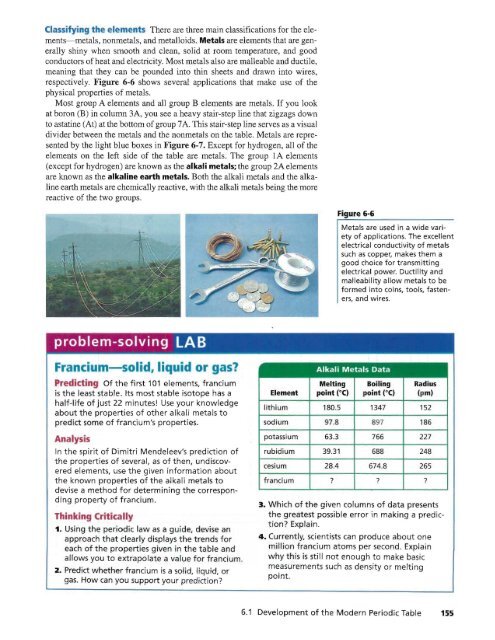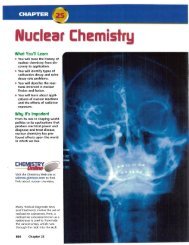Chapter 6
Chapter 6
Chapter 6
You also want an ePaper? Increase the reach of your titles
YUMPU automatically turns print PDFs into web optimized ePapers that Google loves.
Class ify"ng the eleme ,There are three main classifications for the elements-metals,<br />
nonmetals, and metalloids. Metals are elements that are generally<br />
shiny when smooth and clean, solid at room temperature, and good<br />
conductors ofheat and electricity. Most metals also are malleable and ductile,<br />
meaning that they can be pounded into thin sheets and drawn into wires,<br />
respectively. Figure 6-6 shows several applications that make use of the<br />
physical properties of metals.<br />
Most group A elements and all group B elements are metals. If you look<br />
at boron (B) in column 3A, you see a heavy stair-step line that zigzags down<br />
to astatine (At) at the bottom ofgroup 7A. This stair-step line serves as a visual<br />
divider between the metals and the nonmetals on the table. Metals are represented<br />
by the light blue boxes in Figure 6-7. Except for hydrogen, all of the<br />
elements on the left side of the table are metals. The group IA elements<br />
(except for hydrogen) are known as the alkali metals; the group 2A elements<br />
are known as the alkaline earth metals. Both the alkali metals and the alkaline<br />
earth metals are chemically reactive, with the alkali metals being the more<br />
reactive of the two groups.<br />
Figure 6-6<br />
Metals are used in a wide variety<br />
of applications. The excellent<br />
electrical conductivity of metals<br />
such as copper, makes them a<br />
good choice for transmitting<br />
electrical power. Ductility and<br />
malleability allow metals to be<br />
formed into coins, tools, fasteners,<br />
and wires.<br />
•<br />
clum 01 d. i u d or gas<br />
e icting Of the fi rst 101 elements, francium<br />
is the least stable. Its most stable isotope has a<br />
half-life of just 22 minutes! Use your knowledge<br />
about the properties of other alkali metals to<br />
predict some of francium's properties.<br />
A alys-s<br />
In the spirit of Dimitri Mendeleev's prediction of<br />
the properties of several, as of then, undiscovered<br />
elements, use the given information about<br />
the known properties of the alkali metals to<br />
devise a method for determining the corresponding<br />
property of francium.<br />
Thi kin<br />
elf cally<br />
1. Using the periodic law as a guide, devise an<br />
approach that dearly displays the trends for<br />
each of the properties given in the table and<br />
a"'ows you to extrapolate a value for francium.<br />
2. Predict whether francium is a solid, liquid, or<br />
gas. How can you support your prediction<br />
Alkali Metals Data<br />
Melting Boiling Radius<br />
Element point (Oe) point (0C) (pm)<br />
I,ithium 180.5<br />
sodium 97.8 897<br />
I<br />
1347 152<br />
I<br />
186<br />
potassium 63.3 766 227<br />
rubidium 39.31 688 248<br />
cesium 28.4 674.8 265<br />
francium 7 <br />
J. Wfilich of the given columns of data presents<br />
the greatest possible error in making a prediction<br />
Explain.<br />
4. Currently. scientists can produce about one<br />
mi'llion francium atoms per second. Explain<br />
why this is still not enough to make basic<br />
measurements such as density or melting<br />
point.<br />
6.1 Development of the Modern Periodic Table 155












